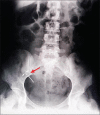Intrauterine Contraceptive Device Perforating the Cecum, a Pregnancy Complication?
- PMID: 31143630
- PMCID: PMC6515750
- DOI: 10.4103/GMIT.GMIT_109_18
Intrauterine Contraceptive Device Perforating the Cecum, a Pregnancy Complication?
Abstract
Intrauterine contraceptive device (IUCD) is a widely used method of contraception worldwide. Displacement of the IUCD extrauterine, by perforating the uterus and migration, is a serious complication following its insertion. We reported an extremely rare case of a 24-year-old female patient found to have a copper T 380A IUCD displaced from its normal site to be embedded into the cecum, suggested to have occurred during pregnancy, and being successfully removed laparoscopically.
Keywords: Cecal perforation; intrauterine device; laparoscopy.
Conflict of interest statement
There are no conflicts of interest.
Figures


Similar articles
-
Case report of an unusual finding of intrauterine contraceptive device in the rectum.Int J Surg Case Rep. 2024 Mar;116:109436. doi: 10.1016/j.ijscr.2024.109436. Epub 2024 Feb 23. Int J Surg Case Rep. 2024. PMID: 38422748 Free PMC article.
-
Removal of a Migrated Intrauterine Contraceptive Device Perforating the Terminal Ileum: A Case Report.Cureus. 2022 Sep 29;14(9):e29748. doi: 10.7759/cureus.29748. eCollection 2022 Sep. Cureus. 2022. PMID: 36340548 Free PMC article.
-
Laparoscopic removal of translocated intrauterine contraceptives devices.Br J Obstet Gynaecol. 1982 Feb;89(2):163-5. doi: 10.1111/j.1471-0528.1982.tb04686.x. Br J Obstet Gynaecol. 1982. PMID: 6461352
-
[The migrating intrauterine device. Case report and review of the literature].Contracept Fertil Sex. 1999 Oct;27(10):696-700. Contracept Fertil Sex. 1999. PMID: 10605179 Review. French.
-
Insertion of an intrauterine contraceptive device after induced or spontaneous abortion: a review of the evidence.BJOG. 2001 Nov;108(11):1168-73. doi: 10.1111/j.1471-0528.2003.00264.x. BJOG. 2001. PMID: 11762657 Review.
Cited by
-
Ineffective Pelvic Magnetic Resonance Imaging for the Detection of a Levonorgestrel-releasing Intrauterine System Straying into the Abdominal Cavity.Gynecol Minim Invasive Ther. 2025 May 22;14(2):174-177. doi: 10.4103/gmit.GMIT-D-24-00009. eCollection 2025 Apr-Jun. Gynecol Minim Invasive Ther. 2025. PMID: 40521579 Free PMC article.
References
-
- Pocius KD, Bartz DA. Intrauterine contraception: Management of side effects and complications. In: Schreiber CA, editor. UpToDate. Waltham, Massachusetts: 2018. [Last accessed on 2018 Oct 25]. UpToDate. Available from: https://www.uptodate.com/contents/intrauterine-contraception-managemento... .
-
- Bozkurt M, Yumru AE, Coskun EI, Ondes B. Laparoscopic management of a translocated intrauterine device embedded in the gastric serosa. J Pak Med Assoc. 2011;61:1020–2. - PubMed

